.
Nine-point circle
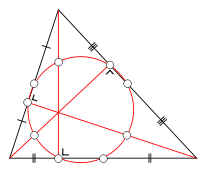
The nine points
In geometry, the nine-point circle is a circle that can be constructed for any given triangle. It is so named because it passes through nine significant points, six lying on the triangle itself (unless the triangle is obtuse). They include:
* The midpoint of each side of the triangle
* The foot of each altitude
* The midpoint of the segment of each altitude from its vertex to the orthocenter (where the three altitudes meet)
The nine-point circle is also known as Feuerbach's circle, Euler's circle, Terquem's circle, the six-points circle, the twelve-points circle, the n-point circle, the medioscribed circle, the mid circle or the circum-midcircle.
Significant points
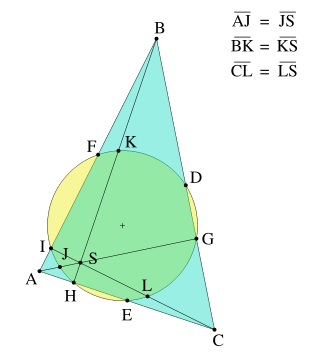
Figure 1
The diagram above shows the nine significant points of the nine-point circle. Points D, E, and F are the midpoints of the three sides of the triangle. Points G, H, and I are the feet of the altitudes of the triangle. Points J, K, and L are the midpoints of the line segments between each altitude's vertex intersection and the triangle's orthocenter (point S).
Discovery
Although he is credited for its discovery, Karl Wilhelm Feuerbach did not entirely discover the nine-point circle, but rather the six point circle, recognizing the significance of points the midpoints of the three sides of the triangle and the feet of the altitudes of that triangle. (See Fig. 1, points D, E, F, G, H, and I.) (At a slightly earlier date, Charles Brianchon and Jean-Victor Poncelet had stated and proven the same theorem.) But soon after Feuerbach, mathematician Olry Terquem himself proved the existence of the circle. He was the first to recognize the added significance of the three points that are the midpoints of the line segments formed between the vertices of the triangle's altitudes and the triangle's orthocenter. (See Fig. 1, points J, K, and L.) Thus, Terquem was the first to use the name nine-point circle.
Tangent circles
In 1822 Karl Feuerbach discovered that any triangle's nine-point circle is externally tangent to that triangle's three excircles and internally tangent to its incircle; this result is known as Feuerbach's theorem. He postulated that:
... the circle which passes through the feet of the altitudes of a triangle is tangent to all four circles which in turn are tangent to the three sides of the triangle... (Feuerbach 1822)
The point at which the incircle and the nine-point circle touch is often referred to as the Feuerbach point.
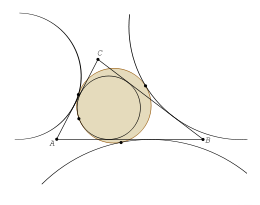
The nine-point circle is tangent to the incircle and excircles
Other interesting facts
* The radius of a triangle's circumcircle is twice the radius of that triangle's nine-point circle.
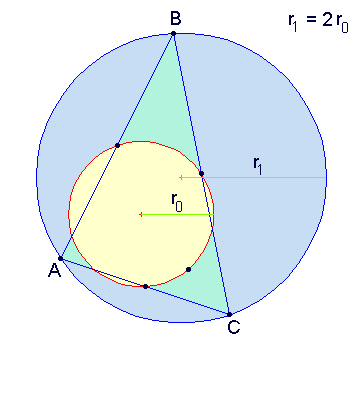
* A nine-point circle bisects a line segment going from the corresponding triangle's orthocenter to any point on its circumcircle.
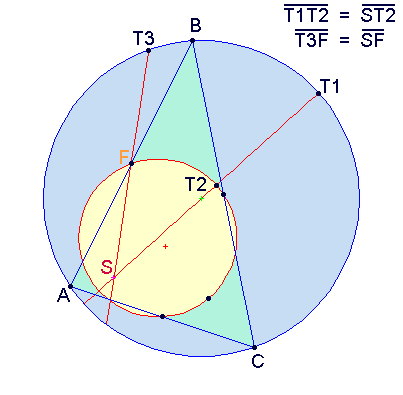
* The center of any nine-point circle (the nine-point center) lies on the corresponding triangle's Euler line, at the midpoint between that triangle's orthocenter and circumcenter.
* If an orthocentric system of four points is given, then the four triangles formed by any combination of three distinct points of that system all have the same nine-point circle.
* The centers of the incircle and excircles of a triangle form an orthocentric system. The nine-point circle created for that orthocentric system is the circumcircle of the original triangle. The feet of the altitudes in the orthocentric system are the vertices of the original triangle.
* If four arbitrary points A, B, C, D are given, then the nine-point circles of ABC, BCD, CDA and DAB concur at a point.
* The center of the Kiepert hyperbola lies on the nine-point circle.
* The center of the Jerabek hyperbola lies on the nine-point circle.
* The orthopole of line passing through the circumcenter lie on the nine-point circle
* Trilinear coordinates for the nine-point center are ![]() .
.
* Trilinear coordinates for the Feuerbach point are ![]()
* Trilinear coordinates for the center of the Kiepert hyperbola are (b2 − c2)2/a : (c2 − a2)2/b : (a2 − b2)2/c
* Trilinear coordinates for the center of the Jerabek hyperbola are cos A sin2(B − C) : cos B sin2(C − A) : cos C sin2(A − B)
* Letting x : y : z be a variable point in trilinear coordinates, an equation for the nine-point circle is
x2sin 2A + y2sin2B + z2sin 2C − 2(yz sin A + zx sin B + xy sin C) = 0.
See also
* Synthetic geometry
* Lester's theorem
References
* Feuerbach, Karl (1822), Eigenschaften einiger merkwürdigen Punkte des geradlinigen Dreiecks und mehrerer durch sie bestimmten Linien und Figuren.
Links
* Encyclopedia of Triangles Centers by Clark Kimberling. The nine-point center is indexed as X(5), the Feuerbach point, as X(11), the center of the Kiepert hyperbola as X(115), and the center of the Jerabek hyperbola as X(125).
* History about the nine-point circle based on J.S. MacCay's article from 1892: History of the Nine Point Circle
* Nine Point Circle in Java at cut-the-knot
* Feuerbach's Theorem: a Proof at cut-the-knot
* Special lines and circles in a triangle (requires Java)
Undergraduate Texts in Mathematics
Graduate Studies in Mathematics
Retrieved from "http://en.wikipedia.org/"
All text is available under the terms of the GNU Free Documentation License

